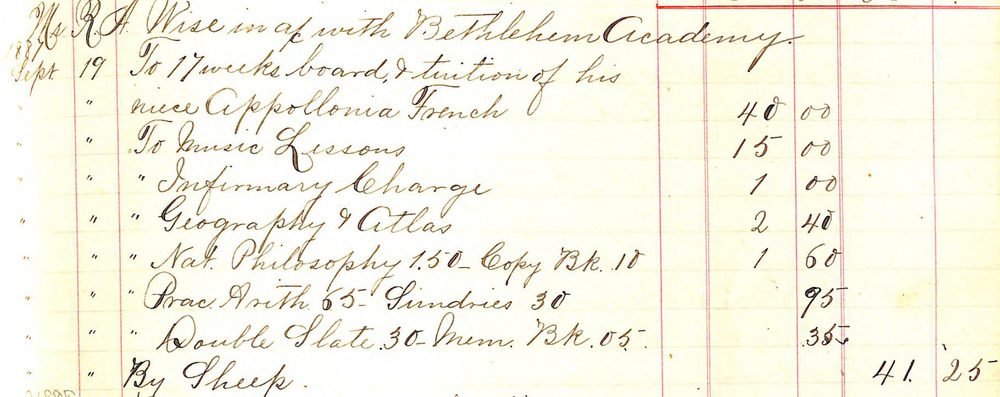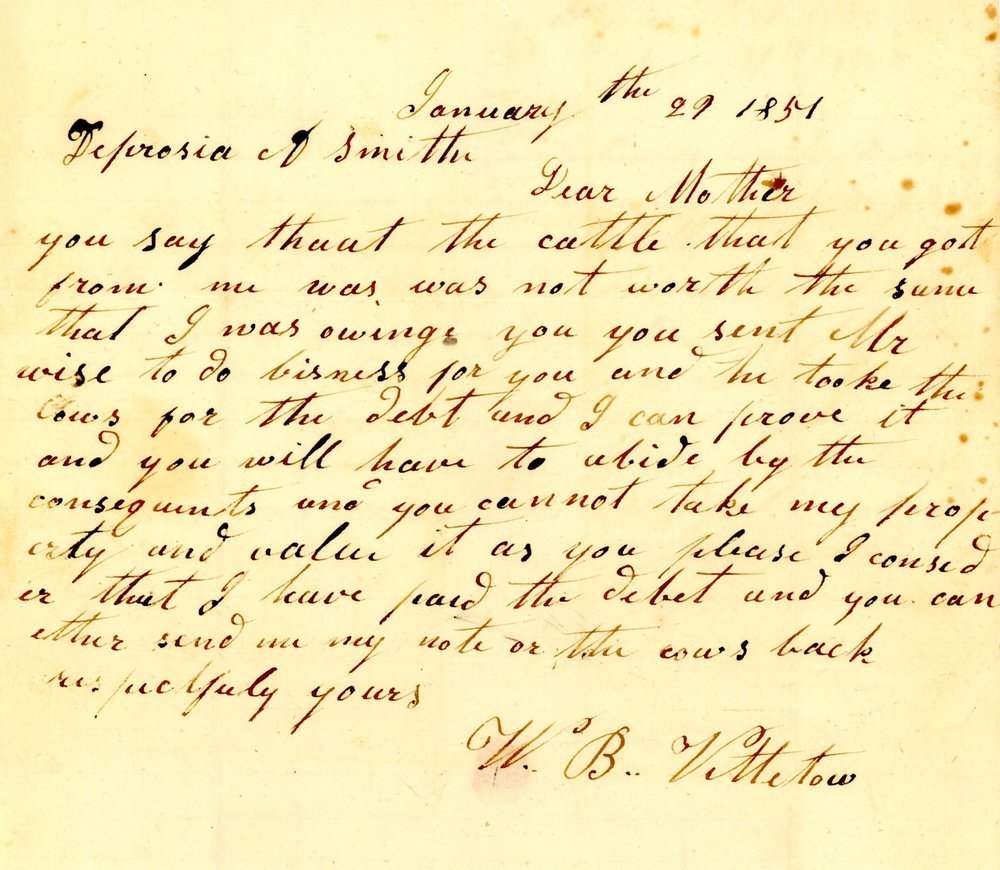Tales from the Ledgers: Bartering in Early Loretto Academies
Posted on July 28, 2022, by Loretto Community
By Katie Daugherty
The Heritage Center is thrilled to welcome Katie Daugherty as our 2022 summer intern. Katie comes from Sylva, NC, where she is Head of the Circulation Department at her local public library. She recently completed a Post-Graduate Certificate in Archival Studies from Louisiana State University. Over the summer, her projects have included processing archival collections, working with Loretto’s digital biographical records, and re-housing historic textiles.
While much can be gleaned about nineteenth-century life at Loretto academies through the Heritage Center’s collections of annals, photographs, and correspondence, no other documentation provides quite the same perspective as the school ledgers. These account books or day books were used by the Sisters to monitor all finances going in and out of the schools. The surviving books include student account ledgers, which kept track of what individual pupils owed and the payments they made, and school account ledgers, which kept track of the various services and supplies the Sisters purchased to keep the schools running.
While it is certainly interesting to look at what students requested during their time at the academies and what the Sisters were purchasing back in the nineteenth century, one of the most fascinating aspects of these ledgers is the occurrence of trade and bartering. As the schoolchildren were acquiring bills for a variety of items, families paid with a similar breadth of variety. Looking at the ways in which parents and families paid for their children’s various school bills gives insight into not only the Loretto schools, but also the greater American economics of the time.
Even though cash payments were the most regularly occurring transaction, there were still many families who paid through goods and services. As was commonplace during the 1800s, items or services would be assigned a monetary value, sometimes by the singular item and sometimes by a measuring unit such as by the bushel, pound, or hour’s worth of work. Then, according to the quantity of the item, the total monetary value would be entered into the ledger as a credit.
Here is an example of Appollonia French’s student account from Bethlehem Academy (Hardin County, KY) in 1887, with debits listed for tuition and board, some necessary books and supplies, and an infirmary stay. You’ll notice, at the end of her debits, that $41.25 of credit was paid toward her account by sheep.

There are many examples of this type of trade throughout all of the early Loretto schools. For example, at St. Mary’s Academy in Denver, CO, a credit of 200 lbs of wool at 15 cents per lb, totaling $30, was paid in 1884. In December 1883, at Holy Mary’s on the Rolling Fork (Marion County, KY), another family paid $1.70 worth of cabbage towards their child’s debt. At Loretto Academy (Nerinx, KY) in 1844, one student’s schooling was paid for with $48.81 worth of smith work. A student enrolled at St. Joseph’s Academy in Cairo, IL, had her schooling paid for with 30 lbs of butter, a dozen chickens, and $2.35 worth of eggs. Steer, veal, beef, oxen, horses, sheep, lard, pork, wood, wool, hay, flour, meal, wagons, molasses, and even whiskey were all used to pay for schooling. Sometimes labor, such as threshing grain or smith work, was also traded for credit.
Here are a few examples scanned directly from the school ledgers of items and services received as payment for schooling:





While these ledgers make the bartering and trade system seem fairly straightforward, the payments were not always seamless. Ledgers speak only to the side of the transaction, so it can be difficult to understand the back and forth that might have occurred before the value of items was set. In a letter written by a parent trying to pay his children’s school account in 1854, we can see that there was confusion regarding his payment:

The letter reads:
Dear Mother
You say that the cattle that you got from me was not worth the sum that I was owing you. You sent Mr. Wise to do business for you and he took the cows for the debt and I can prove it and you will have to abide by the consequences and you cannot take my property and value it as you please. I consider that I have paid the debt and you can either send me my note or the cows back.
Respectfully yours, W.B. Vittitow.
It’s important to note that the bartering system was not all trade of livestock and hours of grain threshing work. There are also examples in Loretto ledgers of the labor of enslaved persons being traded to pay for schooling. Instances of persons of color being hired out for months at a time can be found in multiple schools during the 1840s and 1850s.

In this example from 1859 at Bethlehem Academy (Hardin County, KY), $100 of credit was paid towards schooling through the labor of a person of color. To learn more about Loretto’s history with slavery, click here.
While the ledgers reveal plenty of examples of school credits paid through bartering, ledgers from the end of the nineteenth century also reveal that the Sisters turned away from such transactions. This move was mirrored in the wider economic trends of the time. Accompanied by the end of the Industrial Revolution, the American economy was rapidly changing. New technologies led to greater transportation systems throughout the country, which in turn allowed for quicker, more efficient movement of people, ideas, and money. By the end of the nineteenth century, bartering decreased dramatically, and banking replaced the traditions of trading goods and services in the place of money. This decline can be seen in records nearing the turn of the century, as the school ledgers noted fewer and fewer trades of goods for credit, and started exclusively listing “by cash,” “by check,” or “by note.” Though the trading and bartering eventually ended, we are lucky to have examples and documentation of such occurrences within our collection.

Hello:
I have inherited what I have been told is the graduation medal from my Great Aunt Josephine H. DesRocher from Loretto Academy. The phrase “Vesticia Nuiia Retrorsuvi” is on the front of the metal. Would this be from one of your schools? Is there anything you can tell me about my Great Aunt and what she studied there? I think it was nursing.
Dear Ms. Austin,
Thank you for your inquiry. We have forwarded it on to Loretto Archives.